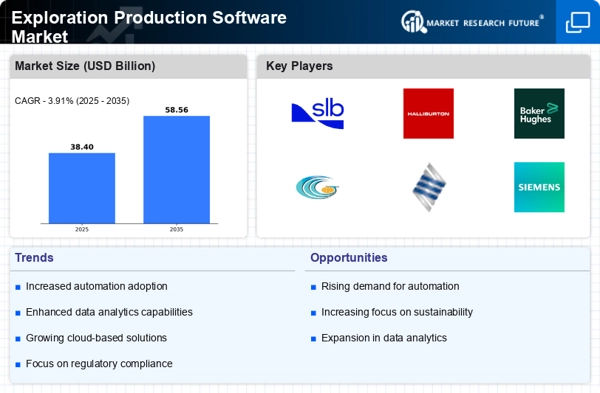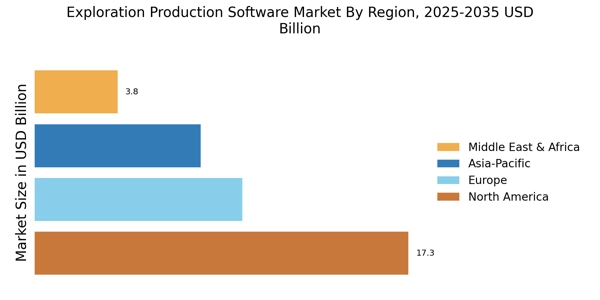The Exploration Production Software Market is currently characterized by a dynamic competitive landscape, driven by technological advancements and the increasing demand for efficient resource management. Key players such as Schlumberger (US), Halliburton (US), and Baker Hughes (US) are at the forefront, each adopting distinct strategies to enhance their market positioning. Schlumberger (US) emphasizes innovation through its investment in digital solutions, while Halliburton (US) focuses on strategic partnerships to expand its service offerings. Baker Hughes (US) appears to be concentrating on sustainability initiatives, which may resonate well with the evolving regulatory environment and stakeholder expectations. Collectively, these strategies contribute to a competitive environment that is increasingly shaped by technological prowess and sustainability commitments.
In terms of business tactics, companies are localizing their operations to better serve regional markets, which may enhance responsiveness and reduce operational costs. The market structure is moderately fragmented, with several players vying for market share, yet the influence of major companies remains substantial. This competitive structure allows for a diverse range of solutions, catering to various segments within the exploration and production sectors.
In August 2025, Schlumberger (US) announced a partnership with a leading AI firm to develop advanced predictive analytics tools aimed at optimizing drilling operations. This strategic move is likely to enhance Schlumberger's service offerings, positioning it as a leader in integrating AI into exploration processes. The collaboration may also facilitate improved decision-making for clients, thereby increasing operational efficiency.
In September 2025, Halliburton (US) launched a new cloud-based platform designed to streamline project management and enhance collaboration among stakeholders. This initiative reflects Halliburton's commitment to digital transformation, potentially allowing clients to achieve greater transparency and efficiency in their operations. The platform's introduction may signify a shift towards more integrated solutions in the industry, aligning with broader trends in digitalization.
In July 2025, Baker Hughes (US) unveiled its sustainability roadmap, which includes ambitious targets for reducing carbon emissions across its operations. This initiative not only aligns with global sustainability goals but also positions Baker Hughes as a forward-thinking player in the market. The emphasis on sustainability could attract environmentally conscious clients and investors, thereby enhancing its competitive edge.
As of October 2025, the Exploration Production Software Market is witnessing significant trends such as digitalization, sustainability, and the integration of artificial intelligence. Strategic alliances are increasingly shaping the competitive landscape, enabling companies to leverage complementary strengths. Looking ahead, competitive differentiation is likely to evolve, with a pronounced shift from price-based competition to a focus on innovation, technological advancements, and supply chain reliability. This evolution may redefine how companies position themselves in the market, emphasizing the importance of adaptability and forward-thinking strategies.


















Leave a Comment